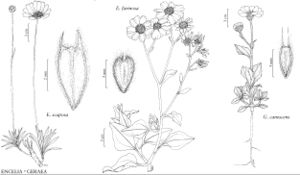Difference between revisions of "Encelia scaposa"
Proc. Amer. Acad. Arts 8: 657. 1873.
FNA>Volume Importer |
imported>Volume Importer |
||
| Line 6: | Line 6: | ||
|place=8: 657. 1873 | |place=8: 657. 1873 | ||
|year=1873 | |year=1873 | ||
| + | }} | ||
| + | |special_status={{Treatment/ID/Special_status | ||
| + | |code=F | ||
| + | |label=Illustrated | ||
| + | }}{{Treatment/ID/Special_status | ||
| + | |code=E | ||
| + | |label=Endemic | ||
}} | }} | ||
|basionyms={{Treatment/ID/Basionym | |basionyms={{Treatment/ID/Basionym | ||
| Line 55: | Line 62: | ||
|publication title=Proc. Amer. Acad. Arts | |publication title=Proc. Amer. Acad. Arts | ||
|publication year=1873 | |publication year=1873 | ||
| − | |special status= | + | |special status=Illustrated;Endemic |
| − | |source xml=https:// | + | |source xml=https://bibilujan@bitbucket.org/aafc-mbb/fna-data-curation.git/src/bb6b7e3a7de7d3b7888a1ad48c7fd8f5c722d8d6/coarse_grained_fna_xml/V19-20-21/V21_290.xml |
|tribe=Asteraceae tribe Heliantheae | |tribe=Asteraceae tribe Heliantheae | ||
|subtribe=Asteraceae (tribe Heliantheae) subtribe Ecliptinae | |subtribe=Asteraceae (tribe Heliantheae) subtribe Ecliptinae | ||
Revision as of 20:58, 27 May 2020
Perennials, 10–30(–60) cm (caudices 1–2 cm diam.). Stems contracted, at soil surface or ± subterranean (except peduncles). Leaves mostly basal; petioles ± wanting or merging with blades; blades greenish to cinereous, (proximalmost scalelike) mostly narrowly oblanceolate to linear, 30–100 mm (including attenuate bases, mostly 1–8 mm wide), faces ± hirtellous to scabrellous. Heads borne singly. Peduncles ± scabrellous. Involucres 12–22 mm. Phyllaries linear. Ray florets 20–40. Disc corollas yellow, ca. 5 mm. Cypselae (cuneate to obovate) ca. 5 mm (faces ± villous); pappi (readily falling) of 2 (± villous) bristlelike awns.
Phenology: Flowering Mar–Apr.
Habitat: Rocky, desert slopes
Elevation: 1300–1700 m
Discussion
Although Encelia scaposa traditionally has been included within Encelia, it seems misplaced here. Its cypselae differ from those of other encelias in lacking a narrowed apical notch and in having more or less villous (rather than mostly glabrous) faces. Molecular evidence suggests that it may be closer to Flourensia than to members of the alliance comprising Encelia, Enceliopsis, and Geraea.
Selected References
None.

